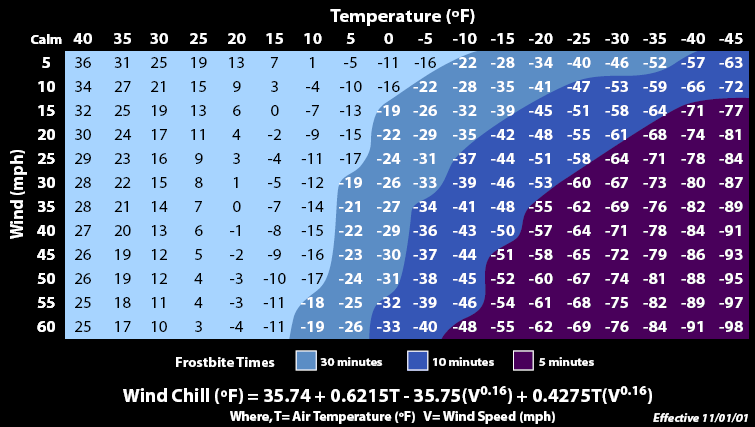How do they calculate wind chill, anyway? The earliest attempt to quantify the effect of wind on perceived temperature was made by Paul Allman Siple and Charles Passel, of the United States Antarctic Service Expedition of 1939–1941. They put water in a plastic tube near an anemometer (wind speed gauge) and measured freeze time. The first wind chill formula was in terms of watts per square meter as a unit of atmospheric cooling: how many watts of energy are transferred to the atmosphere per square meter of surface at a given temperature and wind speed. (Watts per square meter is also the measurement unit for insolation, which is the measure of solar energy available at any given location).
So how did we get to the modern “equivalent degrees” thing (temperature of 18°F, wind chill of [monstrously cold-sounding number here]°F)? This is something of a controversial thing, because of course level of activity, type of clothing, and effect of solar heating, all affect how cold it feels. So sticklers for accuracy prefer the old watts/square meter measurement, where (for example) a heat loss of 400 W/m2is the equivalent of a still temperature of -4°F or -20°C. Which is easier for you to understand? (cf article from the Canadian Encyclopedia)
And yet Ingrid went running in the same windchill for an hour just before I took Anya, and in the same general location, and her physical activity and insulating clothing meant it was uncomfortable only on her exposed cheeks, nearly as unpleasant as my sauntering along with Anya. So pish posh on the windchill table.

And yet... windchill itself is real. We experience wind as adding to our experience of cold. We want to measure cold as an absolute, but our experience of it is much more personal. Not even "subjective" in the sense of it being a matter of personal attitude; I mean each of us has our own metabolism, body shape, level of activity, expectation, and so on, and all these physiological factors affect how our bodies move and generate heat.
Our experience of the cold outdoors is individual, even if the outdoors itself is the same temperature for all of us.
No comments:
Post a Comment